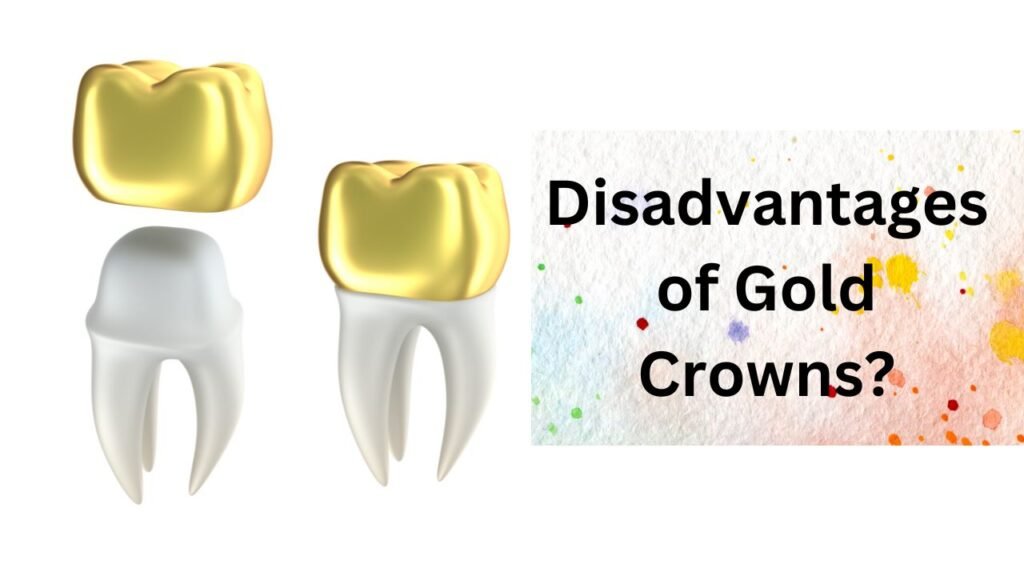When considering dental crowns, gold often stands out due to its durability and long history of use. However, not all that glitters is gold. This post dives deep into the disadvantages of gold crowns to help you make an informed decision.
The Gleam and the Gloom
Gold crowns have been a staple in dentistry for centuries. Their durability and strength make them a reliable option for dental restorations. However, every coin has two sides, and gold crowns are no exception. This article explores the downsides of gold crowns, including cost, aesthetics, potential allergic reactions, temperature sensitivity, and alternatives. By the end, you’ll have a clear understanding of whether gold crowns are the right choice for you.

The Cost of Gold Crowns: More Than Just a Shiny Penny
Gold crowns are undoubtedly more expensive than other types of crowns. This higher cost can be attributed to several factors:
- Precious Metal: Gold, being a precious metal, inherently commands a higher price.
- Craftsmanship: High-quality gold crowns require precise craftsmanship, often increasing laboratory fees.
- Location: Dental fees vary significantly based on geographic location. Urban areas tend to have higher costs compared to rural areas.
Cost Breakdown:
| Factor | Average Cost Range |
|---|---|
| Gold Crown (per tooth) | $800 – $2,500 |
| Dentist’s Fees | Variable |
| Lab Fees | Variable |
Insurance Limitations: Many dental insurance plans do not cover the full cost of gold crowns. It’s crucial to check with your provider to understand your coverage and out-of-pocket expenses. This financial aspect often makes patients consider alternatives.
Aesthetics and Appearance: Not Always a Golden Look
One of the most significant disadvantages of gold crowns is their appearance. Unlike natural tooth-colored crowns, gold crowns stand out due to their metallic color.
- Visibility: Gold crowns can be very noticeable, especially if used on front teeth. This can be a major concern for those who prioritize a natural look.
- Natural Alternatives: Porcelain-fused-to-metal (PFM) crowns or all-ceramic crowns offer better aesthetics. PFMs combine the strength of metal with a more natural appearance, but they can still show a dark line at the gum line.
Visual Comparison:
| Crown Type | Aesthetic Appeal |
|---|---|
| Gold Crown | Low |
| Porcelain-Fused-to-Metal | Moderate |
| All-Ceramic | High |
Potential for Allergic Reactions: Not All That Glitters is Gold
While gold is biocompatible, the alloys used in gold crowns can cause allergic reactions in some individuals.
- Nickel Allergies: Some gold alloys contain nickel, which can trigger allergic reactions. Symptoms include redness, swelling, and mouth pain.
- Statistics: According to the American Dental Association, about 10-20% of the population has a nickel allergy. It’s vital to inform your dentist about any known allergies before choosing a gold crown.
Temperature Sensitivity: Feeling the Heat (and Cold)
Gold is an excellent conductor of heat and cold, which can lead to temperature sensitivity.
- Discomfort: Drinking hot or cold beverages can cause discomfort as the temperature transfers through the gold crown to the tooth underneath.
- Management: While sensitivity often diminishes over time, it can be bothersome initially. Using toothpaste for sensitive teeth and avoiding extreme temperatures can help manage this issue.
Tooth Wear on Opposing Teeth: Gentle but Not Innocuous
While some crown materials can be abrasive to opposing teeth, gold crowns are generally less so. However, they are not entirely free from this issue.
- Abrasiveness: Materials like porcelain can be more abrasive and wear down opposing teeth faster. Gold crowns are gentler but still require careful consideration.
Alternatives to Gold Crowns: Weighing Your Options
If the disadvantages of gold crowns seem significant, several alternatives might better suit your needs:
- Porcelain Crowns: These offer excellent aesthetics and closely resemble natural teeth. They are less durable and can chip more easily than gold crowns.
- Zirconia Crowns: Known for their strength and natural appearance, zirconia crowns are a popular choice. They are highly durable but can be more expensive and difficult to adjust.
- Porcelain-Fused-to-Metal (PFM) Crowns: PFMs provide a balance between strength and aesthetics. However, the metal base can sometimes show through the porcelain, affecting their appearance.
Alternative Comparison Table:
Conclusion: Balancing the Scales
Gold crowns offer exceptional durability and strength, making them a reliable option for dental restorations. However, they come with notable disadvantages such as higher cost, aesthetic concerns, potential for allergic reactions, and temperature sensitivity.
When deciding on the best crown material for your needs, consider factors like budget, desired aesthetics, tooth location (front vs. back), and individual requirements. Discussing these factors with your dentist is crucial in making the best decision for your dental health. Your dentist can help you weigh the pros and cons of gold crowns and explore alternative materials that might better suit your needs and preferences.
Remember, dental decisions are highly individual, and what works best for one person may not be the right choice for another. Always consult with a dental professional to ensure you make an informed and personalized choice for your dental care. For further guidance, schedule a consultation with your dentist today to explore your options.
Find Your Perfect Dentist
Easily book appointments with top-rated dentists in your area
Need Emergency Dental Care?
Get immediate help from verified dental professionals